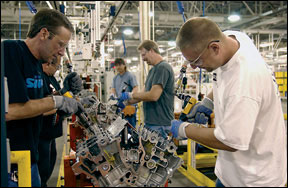
The good (and bad) news is that money, or wages, alone is not the solution. In fact, it often comes in second or even third in terms of employees' reasons for leaving a position. Far more important is an employee's view of his or her role in the company. A worker who feels valued is far more likely to both join and stay with a company for the long haul.
"Remember, we're spending a lot of time at work. It's kind of a lifestyle thing," says Cliff Waldman, an economist for the public policy and research firm Manufacturers Alliance-MAPI (Arlington, VA). "Certainly wages matter, but that doesn't mean you have to double them. As much as anything, you have to create a corporate culture conducive to growth."
With this in mind, many recruiters and managers consider the single most valuable tool for employee retention to be training, both on- and off site-and not just task-specific training. With today's increasingly complicated assembly and manufacturing processes, companies need workers who can think, as well as run a lathe.
"Math skills, cognitive thinking, creative thinking-all these have been cited as issues," says Waldman. "More and more these will be treasured, things that are innate."
Phyllis Eisen, executive director for the Center for Workforce Success and vice president of the Manufacturing Institute, an affiliate of the National Association of Manufacturers (NAM, Washington) agrees. In fact, she notes that the specific nature of the training or education is not half as important as the simple fact that the employer is making the effort. "Research has shown it's a huge retention tool," Eisen says. "It shows employees they are valued in the eyes of the company."
Of course, the immediate response on the part of many manufacturers is that they end up losing money when they educate workers only to have them take those skills someplace else. Professionals in the field, however, say that while this is a danger, implementing a training program as part of an overall corporate culture that values employees can cut this kind of "betrayal" to a minimum.
Welding equipment manufacturer Lincoln Electric (Cleveland), for example, provides training that in many cases could be easily taken to another firm. But a well-established corporate culture that values employees for hard work and initiative keeps them from jumping ship.
"You don't address [employee retention] with one particular thing," says Lincoln Electric vice president of human resources Gretchen A. Farrell. "It's a lot of things working together. There's no silver bullet."
Even in those cases where job training represents the bulk of a company's worker retention efforts, there's no reason that creating smarter workers has to result in their running off to greener pastures. Again, the simple fact that an employer is investing in its workforce makes it a more desirable place to work. Employers can also target their employee training so that the skills learned will be of immediate use on the shop floor.
"Structure the program so it's unique to your company. Make it so that your company becomes an attractive place to use those skills," Waldman says of a well-designed training policy.
Along these same lines, Eisen says managers need to put some thought into the kind of training they want to offer their employees instead of just sending "everybody out to the same computer class."
She recommends that employers first assess their employees to identify gaps in skills and knowledge using tests like WorkKeys, created by the American College Testing Program (ACT Inc., Iowa City, IA). They can then focus on the exact kind of training their employees need with the help of organizations like the American Association of Community Colleges (Washington), the U.S. Department of Commerce's Manufacturing Extension Partnership (administered by National Institute of Standards and Technology, Gaithersburg, MD) or Eisen's own Center for Workforce Success.
According to Eisen, hundreds of organizations offer services complementing the traditional in-house, on-the-job education that still constitutes the majority of training most workers receive. She points out that there are more than 1,250 community colleges in the United States, and about half include business and industry centers that cater to workforce development.
Countless equipment manufacturers also offer training on a wide range of manufacturing technologies. Lincoln Electric, for example, has its own welding school. Robotics companies, machine-vision companies and even tool supply companies like AIMCO Corp. (Portland, OR) often have permanent training facilities to help workers make better use of their products. Then there are organizations like Tooling University (Cleveland), which offers classroom and online instruction on everything from welding to lean manufacturing techniques.
For those who still aren't convinced that training is the way to go, that it represents an unacceptable "cost" as opposed to an "investment," Eisen offers this warning: "The only alternative is untrained employees, and that's not an alternative, not in this day of global competition. Everybody has the same technology. The only thing that is going to separate us is our processes and our smart employees."
